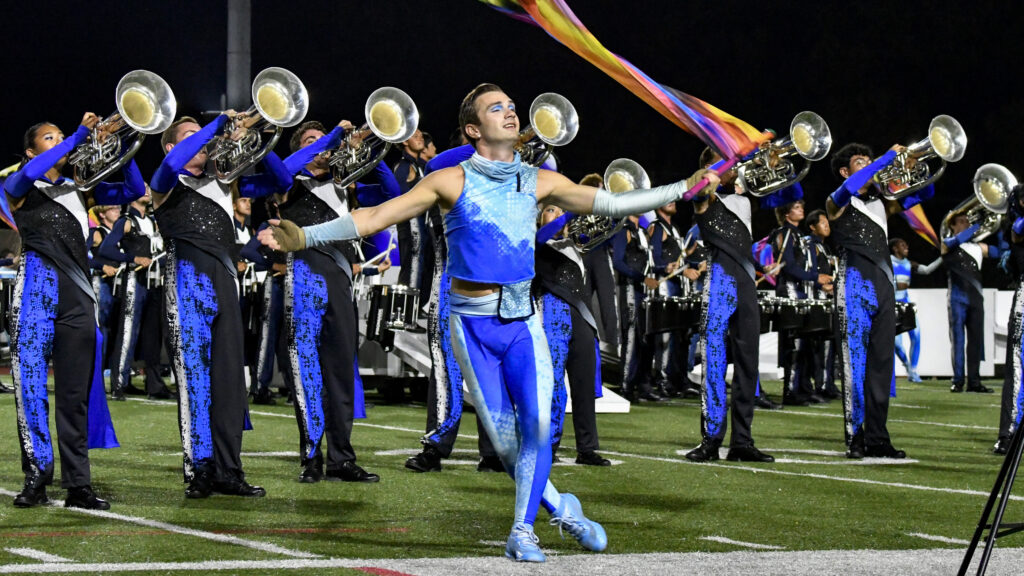
The performing drum corps generated a lot of competitive excitement during the 2009 DCI World Championship Quarterfinals and Semifinals. The Troopers earned a spot in the Finals competition for the first time since 1986, knocking out the Colts by just three tenths of a point. The Academy climbed into 14th place, topping the Madison Scouts. And new to the World Class division was Jersey Surf, a corps that competed in only four contests prior to the last full weekend of July. Taking 19th place at Lucas Oil Stadium in Indianapolis, Pacific Crest’s “El Corazon de la Gente: Alegria, Amor, y Fuerte” conveyed the spirit of Latin America with non-stereotypical music, representing the people of an unnamed village. The literal translation of the title is, “The Heart of the People: Joy, Love, and Strong.” Groups of street musicians seen throughout, fireworks represented in colorful props, and a reference to a bursting pi?±ata and a bullfight were just a few of the visual elements that made this show so vibrantly intriguing. However, the production was subtle in how those preceding elements were presented. One had to keep a sharp eye on the drill formations to catch those references, as nothing in the show actually stated, “And now we present street musicians.” Every reference to life south of the border was seemlessly blended into the fabric of the show.
The village awoke to “Gregoriana” from Juli?ˇn Orbón’s 1957 “Danzas Sinfónicas (Symphonic Dances).” Orbón was born in Spain in 1925 and moved to Cuba with his father in 1940, after which he received a grant to study with Aaron Copland. Disagreeing with the policies of Fidel Castro, he left Cuba during the years of the Communist revolution and moved to Mexico, where he taught composition alongside Carlos Ch?ˇvez. He later moved to the United States. “Gregoriana” is based on a slow and reverent Gregorian plainchant melody, but Orbón altered it so much it ended up reminding some of a spirited Copland tune. It was toward the end of the selection that Pacific Crest presented drill forms resembling exploding fireworks, including a rotating star. The color guard then proceeded in two files down a cathedral aisle, bearing solid white banners wrapped around their bodies that made them appear as angels. On either side of the aisle were the horns, stationary in the formation of the floor plan of a cathedral, playing the plaintive strains of a section from Carlos Ch?ˇvez’s 1936 “Sinfonia India.” Ch?ˇvez was quite fond of introducing Mexican aboriginal folk influences into his music.

Next up was “Impetuosamente (Impetuous),” the second movement from Alberto Ginastera’s “Pampeana No. 3.” Like Orbón, the Argentinian Ginastera also studied with Copland and later taught Astor Piazzolla. The first “Pampeana” was written in 1947 for solo violin and piano, the second in 1950 for cello and piano, and “No 3” for full orchestra in 1954—all three of the works expressing the composer’s vision of the vast expanses of the pampa, the Argentinian prairie. Quite mellow in character was the tranquil segment from Ginastera’s “Variaciones Concertantes,” a 12-segment work from 1953. The selection from the middle of the variations gently wafted into the night sky as it segued into bravado toreador section from Clifton Williams’ “Symphonic Dance No. 3, Fiesta,” originally written in 1964 as one of five “Symphonic Dances” for the 25th anniversary of the San Antonio Symphony Orchestra. This dance was rescored for band in 1967 and is one of the most played band works of the 1960s. With a brief final fanfare based on the end of “Impetuosamente,” the show was brought to a rousing conclusion.
For this week only, you can save on the DVD that contains this complete Pacific Crest performance, along with all corps from Volume II of the 2009 DCI World Championship DVD set.
Buy the 2009 Volume II DCI World Championship DVD. (Available this week only for 20% off. Regular price: $35.95.) DVD discount offer ends Monday, Oct. 13, 2014

Michael Boo was a member of the Cavaliers from 1975-1977. He has written about the drum corps activity for more than a quarter century and serves as a staff writer for various Drum Corps International projects. Boo has written for numerous other publications and has published an honors-winning book on the history of figure skating. As an accomplished composer, Boo holds a bachelor's degree in music education and a master's degree in music theory and composition. He resides in Chesterton, Ind.





